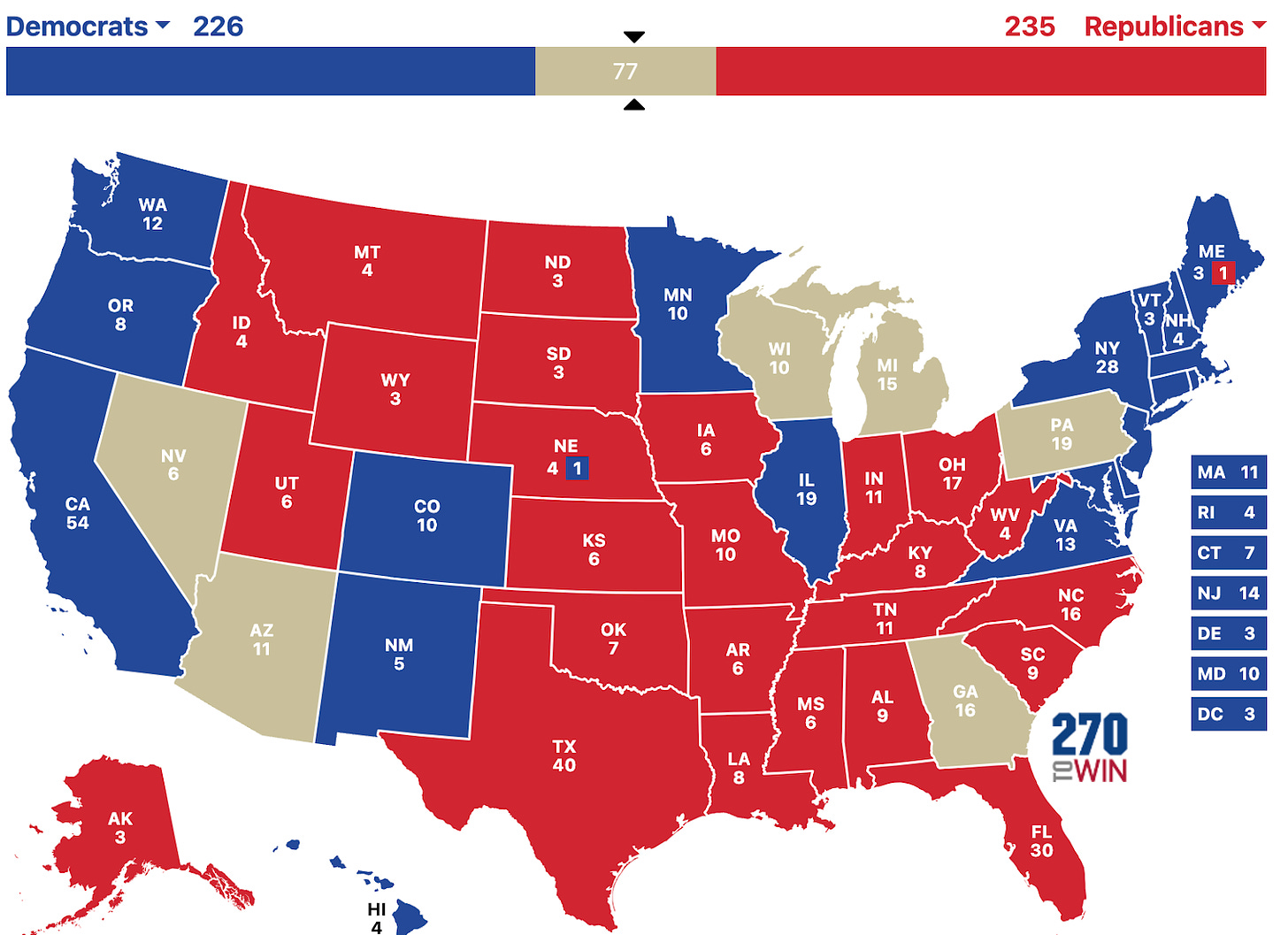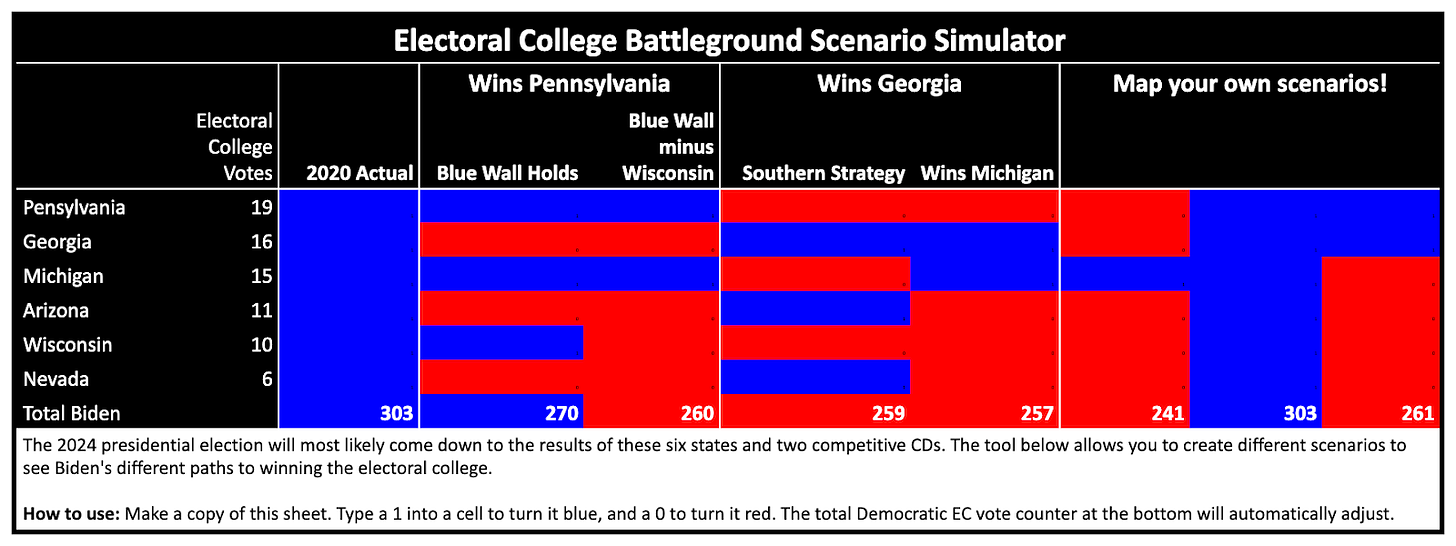The Electoral College Landscape

One of the many reasons I urge people to stop caring about horse race polls is that we already know all we need to know ahead of Election Day: The outcome will be determined, as it was in 2016, 2018, 2020, and 2022, by narrow margins in six battleground states – the three northern states that once constituted the “Blue Wall” (Michigan, Pennsylvania and Wisconsin), and three more diverse states (Arizona, Georgia and Nevada). The margins in these states are usually much too small for any poll to reasonably predict. And we know that Democrats have won in those states only when voters were fully aware that the alternative was MAGA.
In this post, I’ll talk more about those six states and their Electoral College math (including an interactive tool). As always, remember that the outcome in those states will depend not on the margin of error in polls, but on the margin of effort by campaigns, activists, media, and concerned citizens to mobilize America’s anti-MAGA majority.
At this point, we can be pretty confident that the states in play are Arizona (11 electoral votes), Georgia (16), Michigan (15), Nevada (6), Pennsylvania (19), and Wisconsin (10). With those states undecided, the electoral vote tally is Trump 235, Biden 226.1 As a reminder, Biden prevailed in Arizona, Georgia and Wisconsin by less than one point, Pennsylvania by a point, and Michigan and Nevada by about 2 and a half points.
Only Two Paths to 270: Pennsylvania or Georgia + Michigan
To win the Electoral College, Biden must win either Pennsylvania, or both Georgia and Michigan; there is no realistic path to 270 without at least one of these combinations. (This is a change from 2020, when Michigan had one more Electoral College vote and Biden actually had three paths.) Also, remember that a 269-269 tie would throw the determination of the winner to the House of Representatives, where each state’s delegation gets one vote. And if a presidential election outcome is close enough nationally that it results in a 269-269 tie, it is hard to imagine that election resulting in Democrats controlling a majority of state Congressional delegations. (Currently, Republicans hold a majority of representatives in 27 states, compared to Democrats who hold just 22; Minnesota is evenly split. Other than deep-red at-large states, all of the GOP-held state delegations would require flipping at least two seats.2)
Thus, there are only two paths to 270.
-
Pennsylvania (245)
-
The Blue Wall Holds (270).
-
Loses Wisconsin (260). Biden would have to win Georgia (276) or Arizona (271).
-
Loses Michigan (255). This is the least likely along this path, as through the Trump era Democrats have done best in this Blue Wall state. Biden would have to win Georgia (271) or Arizona and Nevada (272).
-
-
Georgia and Michigan (257) Biden has to win two of Arizona, Wisconsin, and Nevada.
Interactive Tool: Try It Yourself
While 270 to Win is a wonderful site, and I definitely recommend scrolling through its historical maps for important perspective on the nation’s persisting sectional alignment, I created an interactive (see below) to make it easier for you to roll through the combinations of battleground states to create your own scenarios.
Simply make a copy of this spreadsheet, and enter “0” or “1” in each cell if you think Trump or Biden will win the state.
Outside the Six Battlegrounds
A scenario in which Biden wins the Electoral College by flipping a state outside of the six in the section above is extremely unlikely, given that it would mean flipping a state that Democratic presidential nominees have not won since 1976 (Texas), 2008 (North Carolina), or 2012 (Florida), while losing at least three of the states that Biden won in 2020 and Democrats carried in the midterms.3
While North Carolina, which Biden lost by 1.3 points in 2020, may theoretically be flippable and within the margin of effort, it also has a very gerrymandered House delegation and no 2024 Senate race, making it a much lower priority for achieving a Democratic trifecta of House, Senate, and White House control than the six battleground states discussed here.
Since Trump fell short by 7.3 points in Minnesota and 7.4 points in New Hampshire, it’s even more unlikely that he would win by picking up either of those states if he falls short in the six battleground states. That said, here’s a piece of New Hampshire trivia. We can’t not think about Florida when we think about Bush’s (s)election in 2000. But had Gore picked up just 7,212 more votes in New Hampshire, the outcome in Florida would not have mattered. Moreover, 2000 was the only one of the nine presidential elections since 1988 in which New Hampshire voted for the Republican nominee. So, if you’re superstitious, aim for 274 in the interactive.
The Post-Election Prisoner’s Dilemma
All of that said, I want to draw attention to the added importance of Biden winning the Electoral College with at least one state to spare. When Brad Raffensperger and other Republican election administrators refused to go along with Trump’s efforts to get them to flip the results in their states in their favor, they were credulously hailed as courageous democracy defenders. The actual story was a bit more complex. In 2020, once Biden was seen to have won Georgia and Arizona, every Republican election administrator faced the classic prisoner’s dilemma: if they “went rogue” and went along with Trump’s demands to alter the real results, but administrators in two of the other five states did not, Biden would still become president and they would face very serious legal liability. If this dynamic changes in 2024, and Republican election administrators in battleground states see a path forward for Trump by cooperating, we can’t presume that they will act with the “courage” Raffensperger did in 2020. That should help us make more sense of those Republican officials like Rusty Bowers who did the right thing in that situation, but who still say they will vote for Trump again.
The importance of winning with at least one state to spare brings the unprecedented importance of Nevada into focus. If you follow through the Electoral College math above, Nevada might seem inconsequential; you’ll see that there are very few scenarios in which losing Nevada would cost Biden the Electoral College majority. But winning Nevada, which is the only one of the six states that Democrats have won in all of the last three presidential elections, is the easiest way to ensure that Biden has an extra state.
Post Election Mischief
There have been several important developments since 2020 to reduce opportunities for post-election mischief and ambiguity. This includes the passage of the Electoral Count Reform Act; the Supreme Court’s ruling in Moore vs Harper discrediting the fabulist “Independent State Legislature” theory; and Democratic victories in critical states. Where, in 2020, there were Republican trifectas in Georgia and Arizona, now they have just Georgia. Where Republicans controlled both chambers of the state legislature in five of the battleground states, they now control both chambers in only two (Arizona and Georgia). And with victories in state supreme courts in Pennsylvania and Wisconsin in 2023, the opportunities for rogue judicial rulings are reduced as well.
January 6th, 2025
In the event that Biden wins, if Democrats have majorities in both chambers that will greatly reduce the possibility of Republican disruption when Congress meets to count the Electoral Votes. The most likely scenario if Biden wins is that Democrats will control the House, but that Republicans will control the Senate – if they can defeat either Brown or Tester. (I’ll be doing a deeper dive on those races in the coming weeks.)
The House of Representatives
I think it’s fair to say that if Biden has won the popular vote by enough to secure a majority of the Electoral Votes, Democrats will have also flipped the House. In 2020, Biden carried 226 congressional districts. Taking into account the remapping done since the midterms, Biden won 224 of 2024 districts. Today, assigning all but the Cook toss-up districts to the party they at least lean toward, Democrats are down 202 to 210. But of the 23 toss-up races, all but two are in states Biden carried4, and all but 4 are in districts Biden carried.5 Of those four Biden lost, three elected Democrats to represent them in 2022.
The Senate
Although a new Congress will have been sworn in on January 3, Kamala Harris will remain the presiding officer, meaning that if there is a tie vote, hers will decide the outcome; in other words, Democrats would still be in the majority with 50 seats. While a great deal of attention is understandably being paid to the need for Sherrod Brown and Jon Tester to win their reelections in Red states for Democrats to retain 50 votes in the Senate, it’s important to remember that there are five other competitive Senate races, all in the six battleground states. Of those races, Baldwin in Wisconsin and Casey in Pennsylvania are best-positioned for a Democratic win. Michigan is an open seat, Arizona is complicated by Sinema running as an Independent, and Rosen has a more challenging re-election than is generally recognized given (1) that Democratic margins in Nevada have been narrowing, and (2) Nevada has had the greatest voter turnover since she was elected in 2018.
1 The split congressional districts in Nebraska and Maine are likely to break for Biden and Trump, respectively.
2 North Carolina is also currently tied, but likely to be Republican with the new lines. Meanwhile, Democrats hold only a single-seat majority in Michigan, Pennsylvania, and Virginia, and have a threatened at-large delegation in Alaska.
3 In other words, Biden would lose all three Blue Wall states, but win Arizona, Georgia, Nevada and North Carolina.
4 North Carolina and Ohio are the only states Biden lost that have toss-up districts.
5 Toss-up districts Biden lost in 2020 are CA-41, ME-02, PA-08, and WA-03.
Michael Podhorzer @MICHAELPODHORZER
Former political director of the AFL-CIO. Senior fellow at the Center for American Progress. Founder: Analyst Institute, Research Collaborative (RC), Co-founder: Working America, Catalist. He publishes Weekend Reading. (weekendreading.net)



